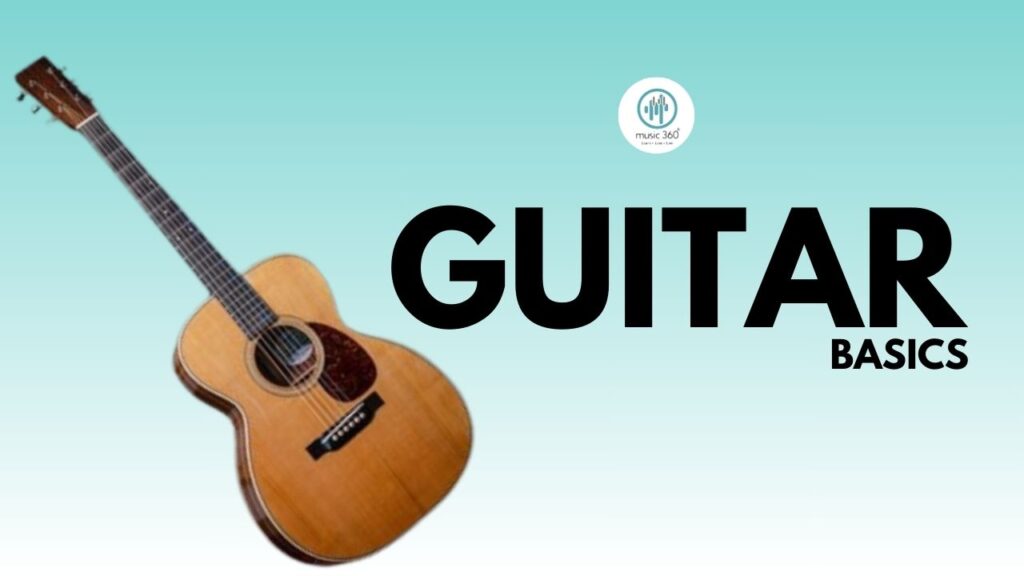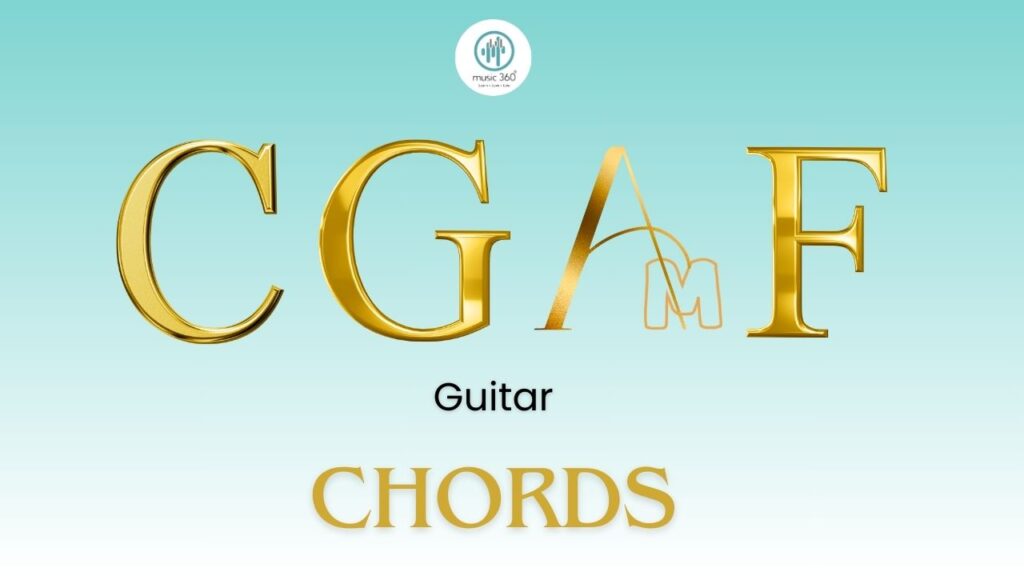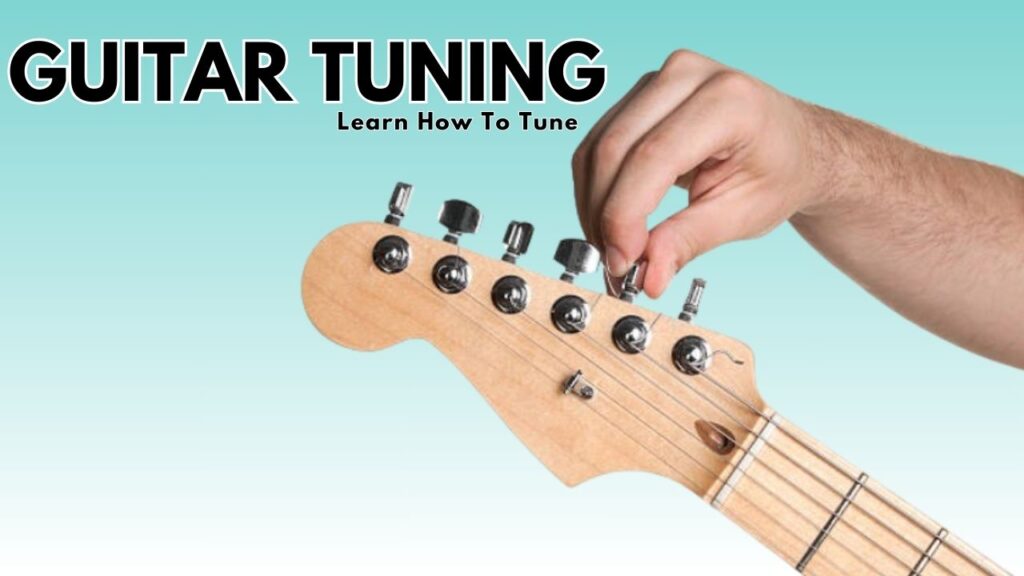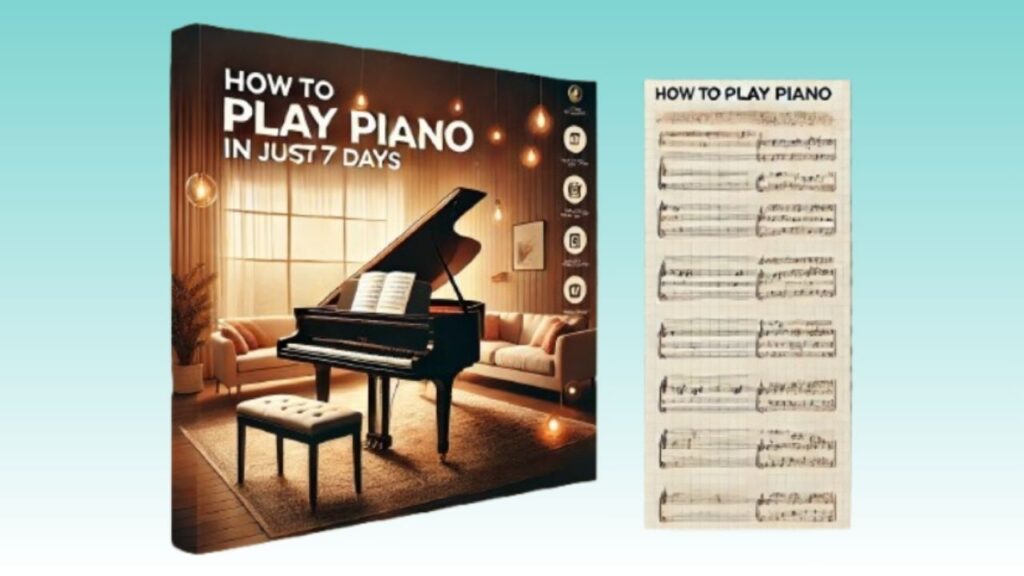The Ultimate Guitar Beginner’s Guide: Learn the Fundamentals in 8 Simple Steps

Table of contents Introduction Guitar basics Tuning the guitar Finger placement and dexterity Playing notes Learning chords Strumming patterns Practicing simple songs More tips and resources Introduction https://youtu.be/QH6w2Yqxc9U Learning to play the guitar helps restructure your brain, making you more creative and focused. It’s more than just making music; it’s about beginning on a transformative journey that will challenge and inspire you in ways you never imagined! I’ve helped hundreds of new guitarists take their initial steps, and I’m thrilled to be your guide on this exciting adventure. By deciphering the secrets of this amazing instrument, we will lay the groundwork for a lifetime of musical delight and innovation. Let’s discover what you have to learn in order to start playing the guitar with confidence! Guitar basics Let’s get into the basic parts of your new musical friend! The guitar is an interesting instrument with different components that combine to produce wonderful music. The body contains the soundhole (for acoustic guitars), and six strings travel along the neck and are attached to the tuning pegs. The fretboard, with metal frets, is where the magic takes place – it’s your musical playground! I’m excited to tell you that beginners have great string choices! While steel strings are ideal for that authentic acoustic or electric tone, nylon strings can be kinder to your fingers when you’re just beginning. I always suggest lighter gauge strings to new players – they’re simpler to press and kinder to your hands. Good posture is your key to success! Sit up straight, place the body of the guitar on your left leg (if you’re right-handed), and hold the neck at a gentle upward angle. Relax your shoulders and keep your back straight – this stance will allow you to play for hours comfortably while holding perfect form! Tuning the guitar It’s crucial to get your guitar into perfect tune for creating lovely music! I always enjoy beginning with the foolproof 5th fret method – it’s an old reliable that has worked for guitarists through the ages. Just tune the low E string first, then use it as your reference and work your way up the string by string in the 5th fret pattern. For the new player, electronic tuning is a lifesaver! Use a good tuning app or a clip-on tuner – they’re amazingly precise and great for beginners. Pluck each string separately, look at the screen, and turn your tuning pegs until you reach that sweet spot. Tune UP to pitch, not down – it keeps your strings in tune longer! The secret to perfect tuning is precision and patience. Be slow and deliberate with every string, and keep in mind: a perfectly tuned guitar is a pleasure to play! Finger placement and dexterity Let’s turbocharge those fingers with some great exercises! Spider Walk is my personal favorite warm-up – position your fingers over nearby frets and slide them along the strings as a spider moving along its web. Move slowly and cleanly at first, then increase your speed as you become more nimble! Diagonal exercises are another game-changer for finger independence! Place your fingers across various frets in a diagonal pattern, then change positions smoothly. I adore doing this with chromatic exercises – playing consecutive notes up and down the fretboard makes those fingers dance! Don’t forget, warm-ups are essential to avoid hand fatigue! Do these exercises for only 5-10 minutes before every session, and you’ll be surprised at how fast your finger strength and coordination will improve. Make sure to keep your movements slow and deliberate – speed will follow naturally with repetitive practice! Playing notes Let’s master the art of creating crystal-clear notes on your guitar! Press your fingertips firmly just behind each fret – that sweet spot where pressure meets precision. I always tell my students to think of it like a perfect handshake: firm but not crushing. You’ll know you’ve got it right when you hear that beautiful, resonant tone without any buzzing! Working the fretboard is your ticket to musical liberty! Every fret is a half-step increase in pitch, an orderly pattern repeated on every string. I adore imagining the fretboard as a grid – the vertical lines are your frets, each one numbered 1-12, repeating up the neck. Keep in mind your first fret is nearest the headstock! Work at moving between frets consciously and intentionally and ensure that every note resonates pure and sweet. Learning chords Time to unlock the building blocks of countless songs! Start with the wonderfully simple Em chord – just place your first and second fingers on the second fret of the A and D strings. It’s the perfect first chord for any beginner! From there, we’ll build up to the mighty A chord (three fingers in a row on the second fret), then tackle C, D, and G. These five magical chords are your gateway to thousands of songs! Practice each shape individually until your fingers automatically snap into position. I love using the “hover method” – lift your fingers slightly off the strings, then place them back down as one unit. This builds muscle memory faster! For seamless transition, I instruct my students always to think as a choreographer. Find common fingers among chords and set those as anchor fingers. For instance, while changing from G to Em, the first finger doesn’t move! Slowly and intentionally practice such transitions – with time, the speed will naturally develop with persistent practice! Strumming patterns Let’s get that strumming hand moving confidently! Begin with the basic down-strum position – rest your pick between your thumb and index finger, keeping your wrist loose. I adore introducing beginners to the easy “down, down, down, down” pattern first – it’s great for establishing rhythm and control! Once you’ve mastered the down-strum, we’ll introduce up-strums! The magic happens when you combine them in patterns like “down-up-down-up” or my personal favorite, “down-down-up-up-down-up”. Keep your wrist loose and moving – imagine painting flowing brush strokes across the air! Don’t forget,
Step-by-Step Method to Practice Scales on Piano for Beginners

Table of Contents Introduction Understanding, what are scales Choosing the right scale Hand posture and finger placement Starting slowly and gradually increasing the tempo Breaking up the scale into manageable sections Practicing regularly Avoiding common mistakes Helpful exercises and drills Maintaining proper finger and hand alignment Applying scales to music Conclusion Introduction Learning piano scales begins with carefully and precisely placing the first stone, much like building a church. These basic patterns provide the foundation for almost every piece of music you will hear, even though many pianists skip over scale practice as a warm-up exercise. The ability to master scales is frequently what distinguishes great pianists from mediocre ones, not their repertoire. This thorough manual efficiently explains how to practice piano scales step-by-step, turning what many people view as a tiresome exercise into the cornerstone of musical brilliance. https://youtu.be/uA_9PLPMqC4 Understanding, what are scales ? Major scales follow distinct patterns of whole and half steps. The C Major scale, for instance, consists of C, D, E, F, G, A, B, C, using only white keys. Minor scales have their own unique patterns, with natural minor scales being most suitable for beginners. The chromatic scale includes all twelve half steps within an octave, making it essential for developing finger independence. When learning piano, scales serve as building blocks for improved technique and musical comprehension. Regular scale practice strengthens finger dexterity and hand coordination. As you work through scales, each finger learns to move independently while maintaining smooth transitions. This technical foundation becomes invaluable as you progress to more complex pieces, supporting both your improvisational abilities and overall musical growth. Choosing the right scale The C Major scale stands as an ideal starting point for beginners, requiring only white keys on the piano. This simplicity allows new players to focus on proper fingering and hand position without the added complexity of black keys. https://music360world.com/how-to-play-the-c-major-scale-on-piano/ As you build confidence with C Major, moving to G Major and F Major introduces basic key signatures. These scales add black keys gradually, helping you adapt to new finger patterns. A minor and E minor scales come next, teaching the concept of relative keys while maintaining similar fingering patterns. Starting with major scales builds a strong understanding of key signatures and tonality. Once you master these basics, you can move toward more intricate scales, but maintaining a solid foundation with simpler scales proves most beneficial for long-term progress. Hand posture and finger placement Maintaining relaxed hands forms the cornerstone of proper piano technique. Keep your hands loose and fingers naturally curved, as if holding a small ball. This position helps prevent strain and allows for fluid movement across the keys. For thumb placement, position it slightly inward, maintaining a gentle curve rather than keeping it straight. When playing the C Major scale, the right hand follows a specific pattern: thumb on C, index on D, middle on E, then pass the thumb under to F. The left-hand mirrors this pattern, starting with the pinky. Watch out for common technical issues: straight thumbs create tension and limit mobility, while collapsed finger joints reduce control. To address these problems, practice slowly with attention to hand shape. Think of your hands forming a dome, with knuckles raised and fingers maintaining their curved position throughout scale practice. Starting slowly and gradually increasing the tempo Begin scale practice at a measured pace, using a metronome set between 60-72 beats per minute. Focus on playing each note with clarity and precision, maintaining consistent timing between notes. This slow practice allows your fingers to learn proper movement patterns while building muscle memory. Only increase your tempo after you can play the scale flawlessly at your current speed. Add 4-8 beats per minute to your metronome setting when you’re ready to progress. If mistakes occur at a higher speed, return to the previous tempo until you regain accuracy. Many piano students make the error of rushing to faster speeds before mastering proper technique. This leads to sloppy playing and incorrect finger patterns. Remember: accuracy trumps speed. A clean, precise scale played slowly holds more value than a fast, uneven performance. Breaking up the scale into manageable sections Start by mastering the first four notes of your chosen scale. For example, in C Major, focus solely on C-D-E-F until you can play these notes smoothly with proper fingering. Practice this small segment repeatedly until it feels natural and comfortable. Once you’ve mastered the initial segment, add the next three notes to your practice routine. In C Major, this means adding G-A-B to your pattern. Work on connecting the two segments smoothly, paying special attention to the thumb crossover. Finally, connect all segments by incorporating the final octave note. Start slowly, maintaining even timing between each section. This methodical approach makes learning scales less overwhelming and builds strong muscle memory. Remember to practice each section’s hands separately before combining them, allowing for better control and accuracy in your playing. Practicing regularly Setting aside dedicated time for scale practice shapes your musical growth. Start with 10-15 minutes of focused scale work at the same time each day, making it part of your daily piano routine. Morning practice often yields better results, as your mind stays fresh and alert. Create a practice schedule that fits your lifestyle. Some pianists prefer splitting their scale practice into shorter segments throughout the day. Others incorporate scales into their warm-up routine before tackling more complex pieces. Track your progress in a practice journal, noting tempo increases and technical improvements. This helps maintain motivation and provides clear evidence of advancement. Remember that consistent, focused practice yields better results than sporadic, lengthy sessions. Even on busy days, a brief period of mindful scale practice contributes more to your development than skipping practice entirely. Avoiding common mistakes Several technical errors can hinder your scale practice progress. Playing with excessive force tires your hands quickly and reduces control. Instead, use light, measured pressure on each key. Many pianists also lose focus during repetitive scale practice, leading
How to Learn 100 Songs with Just 4 Chords: The Ultimate Beginner’s Guide to Musical Mastery

Table of content Introduction The power of four simple chord Identifying the 4 fundamental chords Step-by-step journey to chord mastery Let’s play those chords! Taking your playing to the next level Bringing your favorite songs to life Tips to supercharge your practice Your essential tools for your musical journey Tracking your musical progress Common mistakes and quick fixes Additional resources Your musical adventure begins now! Introduction https://youtu.be/QH6w2Yqxc9U Do you know that those simple four chords hold the secret to playing hundreds of popular songs from every genre? From Lady Gaga to The Beatles, this musical secret has inspired dozens of hits, and it’s going to transform your life! These four magical chords—C, G, Am, and F—are your ticket to immediate musical success, regardless of your level of experience or whether you’re returning to music after a long break. Prepare to discover an endless array of musical possibilities and become one of the many musicians who have transformed these basic building blocks into works of absolute beauty! The Power of Four Simple Chords A wealth of musical opportunities may be unlocked by mastering just four chords! You’ll learn how to play hundreds of well-known songs in every genre by learning C, G, Am, and F. These fundamental chords serve as the basis for innumerable successes, such as Imagine Dragons’ “Demons” and John Lennon’s “Imagine”! This musical journey’s universality is what makes it so beautiful. Regardless of your musical preferences—rock, pop, country, or folk—these four chords are frequently heard. It’s similar to possessing a master key that unlocks countless musical opportunities! Identifying the 4 Fundamental Chords Let’s discover how powerful these amazing chords are! The bright, uplifting sound that we all enjoy is produced by combining the notes C, E, and G in C major. G, B, and D are combined in G major to provide a rich, full bodied tone that is ideal for innumerable hits. With its A, C, and E notes, a minor gives songs the emotional touch that makes them genuinely unforgettable. Finally, F major rounds out our musical toolkit with F, A, and C – the perfect complement to complete our progression! Mastering these four powerhouse chords opens up a whole new world of musical possibilities. Each one has its unique character, and together they create pure magic! Step-by-Step Journey to Chord Mastery Ready to master these incredible chords? Let’s begin with the basics of the piano! Put your pinky on G, middle finger on E, and thumb on middle C for C major. You shouldn’t have to strain or stretch your fingers to play each chord; it should seem natural! Practice with both hands to develop that vital coordination. Start out slowly and focus on the chords’ seamless transitions. Use your left hand to play the root note and your right hand to play the entire chord for a richer, fuller sound. Want more flavor? Try inversions! Instead of playing C-E-G, play E-G-C or G-C-E. These variations will give depth and character to your playing, making even the simplest of progressions sound professional! Let’s Play Those Chords! Time to put those amazing chords into practice! Begin with the magic progression C – G – Am – F. This combo is heard in so many hits and is about to become your new best friend on your musical journey! Count it out: 1-2-3-4 for each chord. Feel that rhythm flow through you in a steady groove! Begin at a slow speed, letting each chord ring clear and true. Once you have mastered the fundamental pattern, you can experiment with various strumming patterns or piano rhythms to truly personalize it. Remember, great musicianship is not just about playing the right notes; it’s about feeling the groove! Let the music move through you as you build confidence with these foundational patterns. Taking Your Playing to the Next Level Are you ready to transform those basic chord progressions into something truly magical? Let’s take a look at split chords and arpeggios! Instead of strumming all the notes together, try breaking them apart—play the bass note first, and then roll through the remaining notes. This simple technique will instantly add sophistication to your playing! Don’t be afraid to play with rhythm patterns! Try playing eighth notes instead of quarter notes, or add syncopation by emphasizing off-beats. Mix up your strumming patterns or create flowing arpeggio patterns that cascade up and down the chord tones. These variations will bring your music to life and showcase your growing skills! Bringing Your Favourite Songs to Life Ready to play the songs you love? The internet is your musical playground! You’ll find a ton of chord progressions for thousands of hits on websites like Ultimate Guitar and Songster. They make it very, very easy to start playing your favorite tunes right away! Break down each song into manageable little chunks! Master the verse first, then move on to the chorus. Even complex songs become doable with this approach—and you stay motivated by seeing your quick progress. Want to sound like a pro? Play along with your favorite recordings! Not only is this a lot of fun, but it’s also the fast track to developing rock-solid timing and real feel. Begin by playing along at a slower tempo and then speed up until you’re matching the original perfectly. Tips to Supercharge Your Practice Chunk up your practice into 15–20-minute focused mini sessions! This keeps the task from being overwhelming and your motivation high. Each mini-session should have a singular focus, perhaps nailing the change between C and G or getting that F-chord change just right. Get creative with your left hand! Try playing root notes to create a solid bass foundation while your right hand holds down the chords. This gives your playing instant depth and groove. Better yet, try playing walking bass lines between chord changes! Don’t forget to sing along as you play! Humming or singing the melody as you play the chords trains your ear and makes you internalize the music much
90 Days to Musical Mastery: Your Ultimate Beginner’s Challenge

Table of Contents Introduction – 90 days to musical mastery Section 1 – Understanding the Challenge Section 2 – Getting Started Section 3 – The 90-Day Plan Section 4 – Key Skills to Master Section 5 – Overcoming Challenges Section 6 – Celebrating Your Progress Conclusion Introduction – 90 days to musical mastery The biggest way that music may transform our life is by providing us with a creative outlet and encouraging emotions of joy and calm. Two examples of how music may improve our moods and strengthen our bonds with one another are the calming tones of a piano or the invigorating strumming of a guitar. It’s acceptable to have ever desired to play an instrument but been turned off by the thought. We are thrilled to present the **90 Days to Musical Mastery** challenge because of this! Beginners who are keen to learn the piano or guitar are the target audience for this structured program. You will not only improve your musical abilities but also foster a lifetime love of music if you take on this challenge. Are you prepared to start this life-changing adventure? Let’s get started! Section 1: Understanding the Challenge 1.1 What is the 90-Day Challenge? The **90-Day Challenge** is a focused, structured program for beginners wanting musical mastery with either the piano or the guitar. You only need to spend a few minutes daily, and you are on your way to laying a solid base and picking up essential skills. The challenge is about discipline and commitment—you keep track of your progress and can celebrate your successes. 1.2 Why 90 Days? The 90-day timeline is based on psychological studies that examine the formation of new habits. The average was found to be about 66 days, but we allow a buffer period for flexibility and adaptation of the challenge, making it a 90-day commitment. It is well enough time to get over the initial hurdles, develop skills, and gain in confidence. Evidence also comes from countless stories of musicians who show very significant improvements with consistent practice. 1.3 Who Is This Challenge For? If you’ve always wanted to play an instrument but were put off by your lack of experience, now is your chance. Concerns like whether you’re too old to begin or whether you lack natural skill are common. Remember that all experts were once beginners, and the learning process is just as important as the end result. Section 2: Getting Started 2.1 Choosing Your Instrument: Piano vs. Guitar Piano: Because of its visual layout, which makes learning music theory easier, the piano is a great instrument for beginners. It is a multipurpose instrument that serves as the foundation for numerous musical styles. You can start by using resources like starter books like “Piano for Dummies,” and online tutorials. Guitar: Another excellent choice, the guitar is easy to carry around and fit into almost any genre, from classical to rock. It’s perfect for those who like to play with others or perform at informal settings. Beginner’s guides like “Guitar for Dummies” and plenty of YouTube channels teach you how to get started. 2.2 Getting Started: Essential Equipment and Resources You will want some essential equipment to get going. Piano: A keyboard or digital piano (weighted keys are preferred and tend to feel more authentic) Sheet music and/or beginner’s books A metronome (or metronome app) for keeping time Guitar: Acoustic or electric guitar Tuner (clip-on tuners or good smartphone apps) Beginner’s chord charts and song books In addition to physical instruments, apps such as Simply Piano for piano or Yousician for guitar offer interactive learning. 2.3 Setting Up Your Practice Space Set up an effective practice environment. Look for a peaceful, cozy spot with well-lit surroundings and minimal interruptions. Keep your instrument handy, and to monitor your development, think about keeping a practice diary. Decide on a definite time each day to practice because consistency is crucial. Section 3: The 90-Day Plan 3.1 Overview of the Challenge Structure The 90-Day Challenge is structured into three 30-day phases: Phase 1: Foundational Skills (Days 1-30) – Focus on basic music theory, finger positioning, and simple songs. Phase 2: Intermediate Techniques (Days 31-60) – Introduce more complex chords, scales, and techniques. Phase 3: Performance (Days 61-90) – Work on playing along with backing tracks and preparing for a final performance. 3.2 Daily Practice Routine Weekdays: Try to practice for 20-30 minutes, focused. Warm up with scales, chord exercises, then work on learning new skills or songs. Weekends: Use this time for longer sessions (45-60 minutes) to explore techniques in more depth and learn new pieces. 3.3 Weekly Goals and Progress Tracking Set achievable weekly goals in order to remain motivated. For instance, learn a new chord each week or master a specific scale. Utilize practice journals, apps, or charts to log your progress and celebrate the small victories. Section 4: Key Skills to Master 4.1 Piano Skills Basic Music Theory: Learn about notes, scales, and chords. Once you understand these concepts, your playing and ability to improvise will improve. Technique: Focus on finger positioning, practicing scales, and playing simple songs. This will help you build muscle memory for the long run. Performance: Playing with backing tracks or even recording yourself will make you confident and prepared for any live performance. 4.2 Guitar Skills Basic Music Theory: The knowledge of the basics of a chord, strum pattern, and scale will help you play different songs and styles of music. Technique: Practice finger positioning and basic chords, then try simple songs. If practiced consistently, this will surely develop dexterity and confidence in you. Performance: Like piano, play with backing tracks and record yourself to track your progress and prepare for performances. Section 5: Overcoming Challenges 5.1 Common Obstacles for Beginners As you embark on this trip, you may feel self-conscious, irritated, or short on time. Identifying these emotions and reminding yourself that they are a natural aspect of learning is the first step. Divide work into manageable chunks and
Learn how to correctly tune your guitar like a pro with these easy, step-by-step instructions

Table of contents Introduction Guitar tuning Why you need to tune your Guitar Getting started: Tools you need for tuning Tuning basics in Guitar How to tune your Guitar Other alternatives in tuning Practical tips for stress-free tuning Advantages of mastering Guitar tuning Common errors to avoid in Guitar tuning How to get tuning into a routine Introduction Guitar tuning When you pick up your guitar, the last thing you want is for it to sound totally out of tune. Any pro player cannot have his instrument singing if his strings are way out of pitch. Tuning one’s guitar is a technical skill by itself and the passport to enhanced playing experience. Whether you are a beginner or an expert, tuning is something you must master. Here, we take you through step by step on how to tune your guitar like a pro, with examples, tips, and practical advice. Why You Need to Tune Your Guitar Tuning your guitar is not some routine; it is the very basis of good music. Playing an out-of-tune guitar: Ruins your sound quality: Even perfect technique will not salvage bad tuning. Destroys harmony: Specifically, when played with other instruments. Will frustrate the learning curve: Many beginners quit before realizing it’s not playing wrong; it’s just that tuning is. Tuning your guitar appropriately ensures the following: Right reproduction of sound in each genre Confidence of your play in live gigs or practices Long-term ear training because you will learn what is a correct pitch. Getting Started: Tools You Need for Tuning A good tuner Electronic tuners are accurate and simple to use for novices. Clip-on tuners like the Snark SN5X and pedal tuners like the BOSS TU-3 are excellent examples. Smartphone Apps: Guitar Tuna, sometimes known as Fender Tune, is a mobile application. Many acoustic-electric guitars have tuners incorporated into the preamps. 2. Pitch Pipe or Tuning Fork Old-school but effective, these tools are perfect for developing your ear. 3. Your Ears The last of the skills is learning to tune by ear, which, of course, comes from practice. Tuning Basics in Guitar From the thickest to the thinnest string, the following pitches are used to tune a typical six-string guitar E (6th string) A (5th string) D (4th string) G (3rd string) B (2nd string) E (1st string) This is called Standard Tuning and is a basis for most guitar playing styles. How to Tune Your Guitar Other Alternatives in Tuning Once you get the hang of standard tuning, you can try alternate tunings to find new sounds. 1.Drop D Tuning Tuning: D-A-D-G-B-E How to Use: Drop the 6th string (E) down to D for a heavier sound, often used in rock and metal. 2. Open G Tuning Tuning: D-G-D-G-B-D How to Use: This is good for slide guitar and blues. 3.DADGAD Tuning Tuning: D-A-D-G-A-D How to Use: Warm, resonant tones are frequently employed in folk music. Practical Tips for Stress-Free Tuning Strings must be changed often. Old strings lose elasticity to hold the tune. Change them every month or two if you practice regularly. 2. Tune in a Quiet Place Background noise may interfere with your ear and with tuners. 3. Stretch Your Strings Pull every string gently after tuning so they don’t slip. 4. Learn to Tune by Harmonics Use the 5th and 7th fret harmonics to tune the strings relative to each other. 5. Ear Training Play a pitch from a piano or tuning fork, then try to match it on your guitar. Advantages of Mastering Guitar Tuning Improved Quality of Sound: A guitar that is well-tuned will sound clean and have harmonic tones. Rapid Growth in Music: The ear-resonating method improves the recognition and identification of the pitch. Enhances Performance: When practice or performance is involved, having the right tuning boosts the confidence level. Flexibility: The flexibility of fast tuning to alternative settings allows exploration of a larger musical world. Common Errors to Avoid in Guitar Tuning 1. Over-Stretched Strings This can break strings. Turn pegs slowly and listen closely. 2. Ignore String Gauge Use strings that fit your tuning requirements. Heavy-gauge strings hold alternative tunings better. 3. Miss Double-Checks Always check your tuning after completing to catch small inaccuracies. How to Get Tuning into a Routine 1.Incorporate Tuning into Warm-Up Spend 5 minutes every session tuning up. 2. Try Alternate Tunings Dedicate a day in a week to alternate tunings. 3. Record and Listen Back Play a simple melody, record it, and listen for tuning problems. 4. Participate in the Music360 Community Share your tuning woes and techniques with other musicians and learn together. CTA: Ready to Play Like a Pro? It starts with tuning your guitar: making beautiful music begins here. With these techniques, you’ll not only sound better but feel more confident every time you play. Want to take your skills to the next level? Join Music360 today for expert-guided courses, live sessions, and a supportive music community. Let’s make your guitar journey stress-free and inspiring! https://youtube.com/live/xLrg7MRkXbU?feature=share
The ukulele is the easiest instrument for beginners

Table of contents Ukulele easy instrument Why the Ukulele deserves your attention What makes the Ukulele special as a beginner’s instrument The benefits of learning the Ukulele How to start playing the Ukulele: for beginners Try these easy songs Common mistakes to avoid Why the Ukulele changes your music experience Introduction: Ukulele Easy Instrument If you have always wanted to play a musical instrument but were not sure where to start, let me introduce you to the ukulele. The ukulele is a little, beautiful instrument that is ideal for beginners. Often one calls it the “friendliest instrument,” and it is. It is easy to learn, transportable, and sounds happy, thus being more than popular among those at the very beginning of having music. This guide lets you know why ukulele is, without a doubt, the easiest instrument for beginners. We will provide you with the tips on practice and reveal the many advantages that will have you strumming your very first chords in a jiffy! Hook: Why the Ukulele Deserves Your Attention Just imagine playing your favorite songs today and tomorrow, perhaps by a ukulele. Would it be impossible? Of course, not for the ukulele. This simple instrument is easily adapted to being played by children, adolescents, and adults, meaning it does not require any weeks of practice to play well. What makes the ukulele special as a beginner’s instrument? 1. More wire, more trouble. The instrument seems a bit intimidating if the learner first is exposed to many strings that go with any other stringed instruments; another, the weird positions and twists are required for placing their fingers against its strings. It cannot be said so of a ukulele that happens to have four strings unlike guitars that carry six. 2. Compact Dimensions with Excellent Comfort End It is a size compact and thus comfortable to hold and play; even kids or the users with hands a bit smaller can play it. Felt light and that is what makes it not straining your lap when played thus learning easy with no physical strain at all. 3. Thin nylon strings Unlike the steel guitar strings that might easily hurt your fingertips, the ukulele has nylon strings which are quite gentle. It therefore makes the learning process much more pleasant, especially for someone who is a newbie to stringed instruments. 4. Cheap and easy You do not have to spend a fortune to get your music journey going. The cheapest in the market perhaps are ukuleles, which offer great beginner models starting at $50. Since they are popular, they are almost found in any music store and online. 5. Easy to Use Many beginner ukulele players can strum their first chords and play simple songs within an hour of picking it up. Thanks to its user-friendly design and straightforward chord shapes, you’ll see progress much faster than with other instruments. The Benefits of Learning the Ukulele Builds Confidence Quickly The ukulele is one of those instruments that is quite simple to learn, so beginners will feel very accomplished very fast. If you only know three or four chords—for example, C, G, Am, and F—you can play a variety of popular songs. That builds and wants to practice more. 2. Portable and travel-friendly The ukulele is tiny and portable, making it ideal for travel. You may take it with you to the beach, park, or a friend’s house and play it there. 3. Transient Clustering The ukulele is small but has all kinds of music, from pop to rock and even folk and jazz. This guarantees that you will never feel bored trying all of them. 4. Social and Fun The ukulele has a natural draw to it, the happy sound. Maybe it will be a great instrument to use for group jams or even sing-alongs, reminding us how music brings people closer together. 5. Relation with Other Instruments Actually, the best thing is, really, mastering the ukulele is an excellent springboard to its larger cousins. It’s pretty easy to get all the basic music skills of rhythm, finger coordination, and ear training when starting out with the ukulele. How to Start Playing the Ukulele: For Beginners Choose the right ukulele There are four major sizes of ukuleles, namely soprano, concert, tenor, and baritone. Soprano: The smallest and most traditional, hence ideal for beginners. Concert: A little bigger sound louder. Tenor: Suitable for people whose palms are large, or those who prefer deeper tones. Baritone: Like the guitar but more suitable to the needs of stronger players. Most of the beginners will do just fine with the soprano or concert ukulele. 2. The fundamental chords are learned first. Star with simple chords like C, G, Am, and F. These four chords alone can unlock hundreds of songs. Practice switching between them smoothly, and you’ll be playing music in no time. 3. Learn Basic Strumming Techniques This literally means rhythm strumming; start with something easy-down, down, down, then up and into more complex beats such as up-down or a mix such as up-up-down. 4. Create Online Tutorials Websites like YouTube and Music360 provide online courses with step-by-step easy tutorials for the learner. Look for videos showing the way to play the popular songs so the learning will be exciting and interesting. 5. Practice for at least 10 minutes a day Consistency is the key. Take at least 10-15 minutes each day practicing chords, strumming, and switching between them. Short, focused practice sessions are better than longer, less frequent ones. 6. Proper calibration of your ukulele A well-tuned ukulele sounds so much better, or in other words, makes a more enjoyable practice time. Buy a clip-on tuner or use an app to keep your ukulele in pitch. 7. Join a Ukulele Community Well, most cities nowadays have clubs or meetups for you to play with other people and share your tricks while maintaining a flow of inspiration. Then, of course, there are the online forums and social media groups that connect like-minded players.
Merry Christmas: Carol Of The Bells

Table of contents Meaning behind the song Carol of the bells Carol of the bells song composition Carol of the bells song lyrics Meaning behind the song Carol of the bells The meaning behind “Carol of the Bells” is one of celebration, anticipation, and joy, echoing the sentiments of Christmas and the festive atmosphere that accompanies it. It’s a reminder of the joy and excitement that come with the holiday season, as well as the tradition of spreading goodwill and cheer to others. Carol of the bells song composition Carol of the Bells” is a popular Christmas carol with origins in Ukraine. Originally titled “Shchedryk,” it was composed by Ukrainian composer Mykola Leontovych in 1914. The lyrics were written by Peter J. Wilhousky in 1936. The song’s melody is based on a traditional Ukrainian folk chant called “Shchedryk,” which celebrates the coming of spring and the New Year. However, when adapted into “Carol of the Bells,” the lyrics were changed to reflect the Christmas season and the joyous spirit it brings. The song is characterized by its distinctive and repetitive melody, which evokes the sound of bells ringing. It’s often performed by choirs, orchestras, and other musical ensembles during the holiday season. https://youtu.be/FSCo5dZ42v8?si=WwiFSO2eFqUPeuj7 Carol of the bells song lyrics Hark! How the bells, sweet silver bellsAll seem to say, “Throw cares away”Christmas is here, bringing good cheerTo young and old, meek and the boldDing, dong, ding, dong, that is their songWith joyful ring, all carolingOne seems to hear, words of good cheerFrom everywhere, filling the airOh, how they pound, raising the soundO’er hill and dale, telling their taleGaily they ring, while people singSongs of good cheer, Christmas is hereMerry, merry, merry, merry ChristmasMerry, merry, merry, merry ChristmasOn-on they send, on without endTheir joyful tone to every home Hark! How the bells, sweet silver bellsAll seem to say, “Throw cares away”Christmas is here, bringing good cheerTo young and old, meek and the boldDing, dong, ding, dong, that is their songWith joyful ring, all carolingOne seems to hear, words of good cheerFrom everywhere, filling the airOh, how they pound, raising the soundO’er hill and dale, telling their taleGaily they ring, while people singSongs of good cheer, Christmas is hereMerry, merry, merry, merry ChristmasMerry, merry, merry, merry ChristmasOn-on they send, on without endTheir joyful tone to every home
How to Play Piano in 7 Days: Easy Step-by-Step Guide for Beginners

Table of contents Introduction can you truly learn Piano in Just 7 days? Why learn to play the piano in 7 days? Things you will need before you begin 7 Day Piano Routine Tips to Succeed in Practicing Learning Piano Fast: Benefits Conclusion: Your journey starts here Hook: Can you truly learn Piano in Just 7 days? The piano, to many, is a very difficult instrument that takes years of practice. But what if you could start playing your favorite melodies in just one week? Well, good news is, with proper guidance, regular practice, and clear goals in mind, you can do it! Be you an absolute beginner or even if you have some experience, this 7-day plan will get those fingers going and more confidence building. You can start playing simple songs, know how to use the piano, and even wow your friends by the end of this guide. Let’s begin this seven-day journey that can transform your musical life. Why learn to play the piano in 7 days? Immediate Gratification It won’t take months for you to begin enjoying the act of playing the piano. This 7-day roadmap develops toward reachable goals, with prompt result and feel-good factor included. A solid platform You will realize by the early stages just how to handle music theory, hand positioning, as well as even rhythm. Pretty solid platforms to build even more from. Ingenuity and Relaxation Piano playing is more than a skill; it is a way for you to de-stress, express yourself, or even ignite creativity. You start quickly and integrate the practice of music into your daily routine easily. Things you will need before you begin A Piano or Keyboard Choose a full-sized 88-key piano, but an 61-key keyboard works great for beginners. It must be tuned or working A Quiet Practice Space Choose an environment free of distractions so you can focus while practicing. Daily commitment Spend at least 30 minutes to an hour daily to get full benefits out of this Goal Setting in Inspiring Set goals: for instance, learn playing a certain song or hitting a particular note 7 Day Piano Routine Day 1: Getting familiar with piano Objective: discover the keyboard and general positioning of hands Discovering Music Alphabet The piano keyboard features repeating patters A to G in keys. Locate the middle C as the white key to the left of the two black keys on the middle keyboard. Key Groups White keys are natural notes, from A up to B, C, etc. Black keys: sharps (#) and flats(b). Finger Numbering Use the following finger numbering, in that order: Thumb = 1, Index = 2, Middle = 3, Ring = 4, Pinky = 5. Practice placement of fingers on keys maintaining good posture. Day 2: Play Your First Scale Goal: Learn the C Major Scale and simple finger exercises. C Major Scale Play: C-D-E-F-G-A-B-C (all white keys). Right hand: Thumb on C, cross over after the third finger. Left hand: Pinky on C, cross under after the thumb. Practice Tips Play slowly, listening for even pressure and smooth transitions. Repeat 5 times with each hand, then try both hands together. https://music360world.com/how-to-play-the-c-major-scale-on-piano/ Day 3: Master Basic Chords Goal: Learn simple major and minor chords. Chords to Practice C Major: C-E-G G Major: G-B-D A Minor: A-C-E How to Practice Play each chord with your right hand, playing each note for 4 beats. Do the same with your left hand. Combining Chords Practice changing between C Major, G Major, and A Minor smoothly. Day 4: Learn Rhythm and Timing Objective: Get a feel for rhythm using simple patterns. Clap It Out Clap quarter notes, eighth notes, and whole notes to a metronome at 60 BPM. Use it on the Piano: Play chords like C Major in different rhythms Quarter Notes: Press and release every beat. Whole Notes: Hold for 4 beats. Day 5: Play a Simple Melody Goal: Learn a short, recognizable tune. Recommended Songs “Twinkle Twinkle Little Star” Right Hand: C-C-G-G-A-A-G, F-F-E-E-D-D-C. Practice one line at a time. Practice Tips Start slow, focusing on accuracy over speed. Once comfortable, add the left hand to play basic chords (C and G). Day 6: Combine Melody and Chords Goal: Play melody and accompaniment together. Chord Progression Exercise For “Twinkle Twinkle Little Star”, use these chords: C Major, G Major, A Minor, F Major. How to do it Play the melody using your right hand. Overlap the appropriate chord using your left hand. Day 7: Perform Your First Song Goal: Play a whole song with confidence. Choose an Easy Song “Ode to Joy” or “Happy Birthday” are good to go for a beginner Practice in Sections Work the song up into teeny tiny bits. Perfect each section before combining them. Final Steps Play slowly for accuracy. Gradually increase speed with expression. Tips to Succeed in Practicing Daily Practice: Dedication makes all the difference, even 15 minutes a day would show good improvement. Metronome: The metronome provides steadiness to rhythm and timing. Recordings: Listen back to recordings of your playing for areas of improvement. Community: You contact other learners or experts on Music360 to put your ideas and get criticism. https://music360world.com/6-tips-and-tricks-for-learning-how-to-sing-and-play-piano-at-the-same-time/ Learning Piano Fast: Benefits Confidence booster: Playing songs within a week of time increases one’s enthusiasm to learn more. Improved Brain Power: Musical learning enhances memory, coordination, and concentration skills. Platform to Master Other Skills: Within the 7-day program, you’ll get the base to attack the advanced pieces of work. Relieving Stress: According to research, music proves to decrease stress after a long day of working. https://music360world.com/reasons-why-playing-piano-beneficial-to-brain/ Conclusion: Your journey starts here Learning to play piano within 7 days would seem ambitious, but with organized practice, achievable goals, and an optimistic attitude, it will completely be possible. Playing the instrument for personal enjoyment or merely to prepare for upcoming artistic ventures, what you find here will be enjoyed during your lifetime. Get started with Piano? Join Music360 today and experience professional tuition, live coaching, and support that
Health benefits of chanting: A pathway to stress relief and mindfulness

Table of content Introduction – chanting Why chant? Here’s the hook to get you started Understanding Chanting: What Happens When You Chant? Health Benefits of Chanting General Mantras for Reducing Stress and Awareness Practical Tips to Begin Chanting Science of Chanting Benefits of Chanting over Other Relaxation Practices How to Integrate Chanting in Daily Life Conclusion: Unlocking the Power of Chanting Introduction – chanting This practice is one of the oldest cutting across the world and its spiritual heritage, now coming up again as a complement to mental and physical well-being. Mantras or sacred sounds chant out in their essence from ancient wisdom informed by modern science. Deeply transformative practices include managing stress, developing mindfulness, and optimizing health for someone, thereby making it a health benefit of chanting with examples and practical tips for bringing this transformational practice into life. Why chant? Here’s the hook to get you started. Think waking up feeling calm within and peaceful of heart, then taking on any challenge thrown by life with clarity and focus. Simple, yet very powerful, the way to kick start your day through chanting. Chanting may involve a mantra in Sanskrit or hymn to that simplest of syllables, “Om”; the vibrations set harmony within your mind and body. Now let’s get down into the detail of how such an ancient practice could bring out some modern benefits. Understanding Chanting: What Happens When You Chant? When you chant, sound vibrations pass through your body and activate some parts of the brain and nervous system. The benefits are drawn from: Vibrational Healing: Voice vibrations stimulate the vagus nerve that causes relaxation. Breathing Focus: Controlled breathing during chanting calms the mind and reduces tension. Neuroplasticity: Repeated chanting molds neural pathways, brings positive thoughts, and reduces anxiety. Health Benefits of Chanting Lowers Anxiety and Stress Chanting reduces the stress hormone cortisol and slows the pulse rate. The repetition acts like a natural tranquilizer. Example: Chanting “Om” for 10 minutes a day will lower stress levels, neurophysiology studies claim. Tip: Begin with a 5-minute session, just on the sound and vibrations. Promotes Mindfulness Chanting anchors the mind to the present moment and improves mindfulness and concentration. Example: Repeating saying of the Buddhist chant “Om Mani Padme Hum” helps to more evoke a sense of more about the self of an individual and elicit compassion. Tip: Guided listening in a quiet space for having absolute impacts of the influence of sounds on the brain Improve Cardiovascular Health Chanting enhances oxygenation through deep breathing whereby slowing the blood pressure then an improvement in cardiovascular activity. Example: The rate that hypertension develops reduces as persons chant with slow rhythmic breathing Boost Immunity Chanting activates the parasympathetic nervous system, thus strengthening the immunity of the body. Example: Chanting “Gayathri Mantra” or “Om” triggers hormones that enhance immunity, which is reported in various studies on yoga and meditation practices. Emotional Balance Regular chanting removes pent-up emotions, hence giving a sense of joy and calmness. Example: Chanting hymns or spiritual chants in a group generates a sense of belongingness and purpose, hence enhancing your emotional well-being. Sleep Quality Chanting reduces sleeplessness and increases the quality of sleep due to its soothing effect. Practice: Before sleeping, one can chant the “Shanti Mantra” (Peace Mantra) to relax the mind. General Mantras for Reducing Stress and Awareness 1.Om (ॐ) “Om” is the original sound from which other mantras have been evolved. Benefits: It becomes more relaxing and unifying. Practice tips: Take a comfortable seat, close your eyes, and recite “Om” for ten to fifteen minutes. 2.Gayatri Mantra “Om Bhur Bhuvah Svah, Tat Savitur Varenyam, Bhargo Devasya Dhimahi, Dhiyo Yonah Prachodayat” Benefits: Promotes spiritual growth and mental clarity. Advice: For a fantastic start to the day, repeat this mantra first thing in the morning. 3.Om Mani Padme Hum This Tibetan Buddhist mantra represents wisdom and compassion. Benefits: It eliminates bad feelings and fosters self-awareness. Practice: Recite in sets of 108 times with Mala. 4.Shanti Mantra “Om Shanti Shanti Shanti” Benefits: It invokes peace and harmony. Tip: This is the mantra that one should conclude his or her meditation or yoga practice with. Practical Tips to Begin Chanting 1.Identify Your Space Identify a quiet comfortable place where you can chant without distraction. 2.Concentrate on Breathing Take deep breaths before you start chanting to bring your body and mind in tune. 3.Use a Timer Start with 5-10 minutes of duration and gradually increase it. 4.Practice Daily Consistency is the key. Do it as a daily habit preferably at the same time of day. 5.Chant with Intent Get a meaning behind the mantra for more profound interaction with the activity. Science of Chanting Brain Wave Scientific evidence has it that chanting triggers the prefrontal cortex part of the brain that relates to decisions and control of emotions. Stimulation of the Vagus Nerve Chanting works the vagus nerve responsible for the “rest and digest” response, hence reducing stress. Benefits of Chanting over Other Relaxation Practices Available All Over the Globe: It does not need equipment or previous practice. Instant Results: The mind can relax within minutes by chanting. Relaxation with Self-improvement and Spirituality: It includes all. How to Integrate Chanting in Daily Life Day-to-Day Morning Practice: Initiate the day with a mantra like “Gayatri Mantra.” Mid-Day Revitalizer: Refresh yourself during the day with mantras such as “Om”. Evening Wind-down: Wind down with the soothing mantra that is the “Shanti Mantra.” Conclusion: Unlocking the Power of Chanting Chanting does not only go beyond spiritual practices. Instead, it is an introduction to better health, great mindfulness, and peace of mind. Once chanting is incorporated in one’s life, there is nothing one cannot avail oneself of all the benefits of reduction in stress up to enhancing emotional balance. Call for Action: Turn Your Life around with Music360 Get ready to be transformed by the power of chanting. Music360 guided chanting sessions, expert advice, and support from a community are all yours. Join now and explore the world of chanting for stress
Guitar vs Ukulele: The Ultimate Guide to Choosing the Best Instrument for Beginners

Table of contents Guitar or Ukulele The Ultimate Beginner’s Problem Understanding the Guitar and Ukulele Ease of Learning Cost Comparison Sound and Versatility Practical Tips for Learning Benefits of the Instruments Who Should Opt for Guitar? Who Should Choose Ukulele? Conclusion Introduction – Guitar or Ukulele Learning how to play a musical instrument is just an exciting first step to the discovery of creativity and self-expression. The choice often comes down to two popular instruments for beginners: guitar or ukulele, as they are string instruments and also relatively cheap but packed with many musical opportunities. But which one is best for you as a beginner? In this guide, we’ll compare the guitar and ukulele in a variety of ways-from ease of learning and playing to sound, cost, and practice methods-so you will know by the end which one is better suited for your needs and therefore feel sure about starting your musical journey. The Ultimate Beginner’s Problem You want to start playing music—great! Now here’s the important question: Should you pick a guitar or a ukulele? Both instruments can give you the joy of music, but they are good for different goals, styles, and personalities. Let’s compare them to help you make the best choice for your music dreams. Understanding the Guitar and Ukulele: The Basics The Guitar String Count: 6 strings (normal tuning: E-A-D-G-B-e). Size: Larger than the ukulele, with acoustic, electric, and classical options too. Sound: Powerful, occasional, suitable for rock, pop, blues, classical, and much more Popularity: Used with bands, orchestras, and soloists worldwide The Ukulele Number of Strings: 4 strings: G-C-E-A is the standard tuning. Size: Small, lightweight. Easy to hold and transport Sound: Balmy, cheerful, and tropical. That’s the specific character of Hawaiian music. Popularity: On the rise as a solitary instrument to express oneself, play at parties, and so on Ease of Learning Guitar Advantages Really versatile instrument that thrives in many genres Many different songs available at varying degrees of difficulty to learn Many sources to learn from, including tutorials and sheet music Disadvantages Bulkier and heavier body is too large for smaller people or children Wider neck and more strings require a little bit of strength and dexterity of fingers Use of barre chords- it does take a while to learn. Ukulele Advantages Learning basic chords is simpler on fewer strings. Softer nylon strings gentle on fingers. Perfect instrument for beginners. Less size and light weight manageable for all age groups. Disadvantages Less sound range in comparison to guitar Not regarded as appropriate for specific genres of music, like rock or blues Winner: Ukulele Ukulele is more accessible for an absolute beginner due to the simplicity and ease with which it allows one to learn. Cost Comparison Guitar Entry-level price: $ 100-$300 decent beginner acoustic or classical. Other expenses may include a tuner, a capo, and a guitar stand. Ukulele Starting Budget: $50–$150 for a decent beginner ukulele. Long-Term Investment: Accessorized equipment is minimal, thus less expensive. Winner: Ukulele Overall, the ukulele is cheaper, perfect for those who do not want to spend a lot of money, especially novices who are afraid to spend money on something. Sound and Versatility Guitar Versatile-enough instrument to play almost all types of music, such as pop, classical music, etc. It produces a more resonant, fuller sound due to its size and six-string configuration. https://youtu.be/QH6w2Yqxc9U https://youtu.be/QH6w2Yqxc9U Ukulele Bright, cheerful distinguishable tone and suited well for folk, pop, and traditional Hawaiian sounds. Its versatility is less than the guitar, but it is extraordinary in special niches. Winner: Guitar If you are after an instrument that assumes multiple genres, then the guitar would be unmatched in its versatility. Practical Tips for Learning For Guitar Beginners Start with Open Chords: The chords C, G, and Em are relatively easy for the beginner. A good guitar for beginners will make it easier to play and sound better. Doing exercises such as pressing strings one at a time helps your fingers move better. Choose easy songs with 2–3 chords to stay interested For Ukulele Beginners Learn Basic Strumming Patterns: Down-up and down-down-up-up-down are simple patterns for novice players. Practice Easy Changes: Practice switching between chords such as C, G, Am, and F. Use Its Portability: Bring your ukulele to the park, to the beach, or even on a road trip! Embracing Its Simplicity: Start with easy songs such as “You Are My Sunshine” to feel good about yourself. Benefits of the Instruments Benefits of Guitar Can be a life instrument, maturing with your skills. Play lead, rhythm, and/or bass in music. Acoustic and electric styles available to fit different tastes in music Advantages of Ukulele Easy to learn, thus a great confidence builder for newcomers. Compact size ideal for small children or people with small hands. Pliable and easy to bring along anywhere. https://youtu.be/fK6nSst2_Cg https://youtu.be/fK6nSst2_Cg Who Should Opt for Guitar? If you want to listen to the music genres of rock, blues, or jazz. If you want an instrument that will be versatile in the long run. If you do not mind longer time to gain control and can afford Who Should Choose Ukulele? If you are looking for a fun, easy-to-learn instrument. For softer tone and light, pleasant music. If you want to carry it easily within your affordability. Conclusion: Which is Best for Beginners? The decision between playing the guitar or ukulele depends on your goals, your likes, and the type of music you would like to play. Choose the ukulele if you want something that can be learned rapidly, in a cheap manner, and then easily played. Choose the guitar if you are willing to spend more time and effort on an instrument that can play many types of music. CTA: Start your journey with Music360 today! Be it the guitar or ukulele, Music360 is there to be with you at every step of the way! Learn chords, songs, and techniques quickly as part of our well-crafted beginner courses. Join Music360 and get all your musical desires
